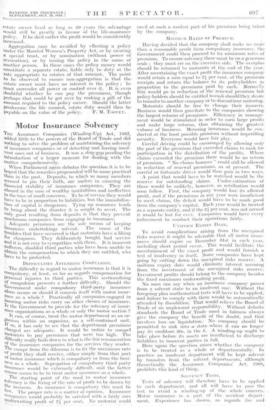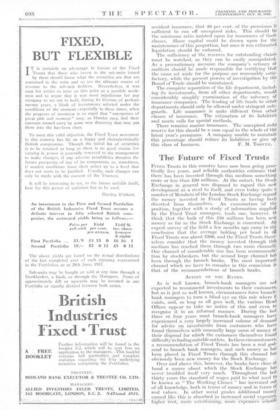.Motor Insurance Solvency
TIIE Assurance Companies (Winding-Up) Act, 1985, 'added little to the powers of the Board of Trade and' did nothing to solve the' problem of maintaining the solVencY of insurance companies or of detecting-and forcing -insol- vent ones out of business. ItWas a stop-gap pending the introduction • of -a larger measure for -.dealing. with the Matter comprehensively.- • When Parliament again:debates the question it is to be hoped that the remedies propounded will be More practical than in the past.. Deposits, to which so many members -Seemed to pin their faith, are useless in ensuring the • financial stabilityof insurance companies. They- are absurd in the case of wealthy institutions and ineffective in the base of small concerns. To be of service they would have to be in proportion to liabilities, but the immobilisa- tion of capital is dangerous. Tying up resources tends to bring about the disaster it is sought to avert. The only good resulting from deposits is that they prevent Innshroom companies from engaging in insurance. 1; Adequate premiums are the sole means of keeping Msnrance undertakings solvent. The cause of the ttorroublesthat have occurred, is that Motorists have a: liking cheapness. They deliberately bought 'bad service 4nd it is not easy to sympathise with them. It is innocent Sufferers, disabled third parties who • have been unable to obtain the compensation to which they are entitled, who !lave to be protected.
DIFFICULTIES ATTENDING COMPULSION.
'•
The difficulty in 'regard to' motor insuranee is that it is eorapulsory, at least., so far as regards compensation for Personal injuries to third parties. This sectionalising 9f compulsion presents a further difficulty.. Should the Government make compulsory third-party insurance alone secure or should it concern itself with motor insur= 6-nee as a Whole ? Practically all companies engaged in Insuring motor risks carry on -other classes of insurance. Is the Government to provide for the solvency of insur- anee Organisations as a whole or only the motor section ?' It can, of course, treat the motor department as an or- ganism within an organism, as a self-cOntained unit, If so, it has only to sec that the department .premiums charged arc adequate. It would be unfair to compel motorists to pay premiums that were too 'high. The difficulty reajly boils down to what is the fair remuneration of the insurance companies for the services they render. The escape from the dilemma is to fix the maximum rate of profit they' shall receive, either' 'simply from that part of motor insurance which is compulsory or from the busi- ness as a whole. Segregation of compulsory third party Insurance would be extremely difficult,' and the better course seems to be to treat motor insurance as a whole.
The starting point of the. road to motor insurance !olveney is• the fixing of the rate of profit to be: drawn by ele insurers. As insurance is compulsory this-inust be '0W- The proper rate is a' matter of opinion. • Insurance companies would probably be satisfied with a fairly sure underwriting profit of 2f per cent. NO motorist could cavil at. .such a- modest part-of his premium being taken by the company.
MINIMUM RATES OF PREMIUM.
Having decided that the company shall make no more than a reasonable, profit from compulsory insurance, the Government- could then proceed to fix minimum rates of premium. To ensure solvency these must be on a generous scale ; they must err on the excessive side. The overplos should be returned to motorists at the end of the year. After ascertaining the exact profit the insurance company would retain a sum equal to 24 per cent. of the preinium receipts and return the balance to its policyholders in proportion to the premiums paid by each. Normally this would go in reduction of the renewal premium but policy-holders.should be entitled to cash should they desire to transfer to another company or to discontinue motoring. Motorists should be free to change their insurers. Business would then gravitate to the companies showing the largest returns of premiums. Efficiency in manage- ment would be stimulated in order to earn large profits and make large • returns,. thus obtaining the greatest volume of business, Motoring insurance would be con- ducted . at. the least possible premium without imperilling security. Everyone would have fair play. Careful driVing could be encouraged by allowing only the part of the premium that exceeded claims to rank for participation in 'the distribution of the profits. Where 'Claims exceeded the premium there would be no return of premium. " No-claims bonuses " could still be allowed in reduction of renewal premiums, as at present. The careful or fortunate driver would thus gain in two ways.
A point that would have to be watched would be the reserve for outstanding claims. Under-estimation of these would be- unlikely, however, as retribution would soon follow. First, the company would lose its allowed profit, and if the premiums in any year were insufficient to meet claims,- the deficit would have to be made good from the company's capital. Each year would be treated as a separate entity, and if the 24 per cent. was not earned it would be lost for ever. Companies would have every inducement to conduct their operations fairly.
UNIFORMS EXPIRY DATE.
To avoid complications" arising from the unexpired risks reserve 'it might be advisable that all motor insur- ances should expire on December 31st in each year, including short period cover. This would facilitate the ascertainment of the exact profit and would furnish a test of insolvency in itself. Some companies have kept going by cutting down 'the unexpired risks reserve. A uniform expiry date would eliminate interest accruing. from the investment of the unexpired risks reserve. Investment profits should belong to the company besides the fixed maximum underwriting profit.
No man can Say when an insinanee company passes from a solvent state to an insolvent have ,(2, b . Without applied, and foregoing plan mathematical' tests will and failure to comply with them would be automatically attended by disSolution.' That would relieve the Board of Trade of an unpleasant responsibility.- Without definite standards the Board of, must in -fairness always give the company the oiefit of the doubt, and that involves loss-on- liquidation:. No- company should be permitted to sink into -a, state-where it can no longer pay its creditors 20s. in the E. A winding-up ought to take place before its assets are insufficient to discharge liabilities to innocent parties in full. Here again the- •question arises whether the company is to be treated as a, whole or departmentally. In practice an insolvent. department will be kept solvent by transfers froth the solVent departments, although theoretically the. Assurance. Companies' Act, 1909, prohibits this kind of thing.:
SOLVENCY TESTS.
Tests of solvency will therefore have to be applied to each department, and all will have to pass the test to avoid a winding-up of the whole concern. Motor insurance • is. -a part of • the, accident depart- ment. Experience has shown, as regards fire and accident insurance, that 40 per cent. of the premiums is sufficient to run off unexpired risks. This should be the minimum ratio insisted upon for insurances of these classes. Share capital could be. drawn upon for the maintenance of this proportion, but once it was exhausted liquidation should be enforced. The sufficiency of the reserves for outstanding claims must be watched, as they can be easily manipulated,. As a precautionary measure the company's actuary Or auditors should be • made responsible for certifying thfit the sums set aside for the purpose are reasonably satis- factory,. while the present powers of investigation by the Board of Trade should be maintained.
The complete separation of the life department, includ-. ing its investments, from all other departments, would ' considerably simplify examination of the solvency Of insurance companies. The lending of life funds to oth6 departments ,should only be allowed under stringent safe- guards. 'Life • assurance is quite different from other classes of insurance. The estimation of its liabilities and assets calls for special methods. There remains marine•insurance. The unexpired risk; reserve for this should be a sum equal to the whole of th.e latest year's premiums. A company unable to maintain this percentage should reduce its liabilities or give up



























































 Previous page
Previous page